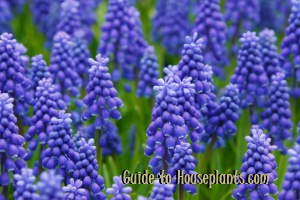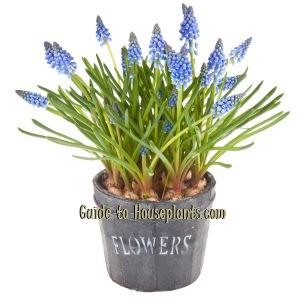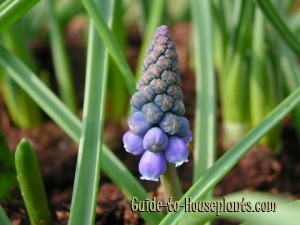





Botanical Name: Muscari spp.
Grape hyacinths are in the same family as hyacinths (Liliaceae), however, they belong to the Muscari genus.
Each hyacinth bulb produces a thick, upright flower stem, which carries a cluster of rounded flowers that resembles a bunch of grapes.

Grape hyacinth flowers are lightly fragrant and available in beautiful shades of lavender-blue to purple, plus pink and white varieties, too.
Surrounding the flower stems are narrow, arching leaves.
Naturally spring-flowering, grape hyacinths are easy to force into bloom mid-winter. The process is called forcing because the bulbs are tricked into behaving as if they've gone through a cold winter, then brought into warmth and sunshine as if it's spring. Flowers last about a month when forced indoors and kept at a cool temperature.
Grape hyacinth bulbs need a cold treatment for 10 weeks to bloom. You can begin the cold process anytime in fall. October is a good time to start for mid-winter blooms. If you have a lot of bulbs, you can plant just a few at a time, keeping the bulbs cold until you're ready to force them. This way, you'll have pots (or vases) in bloom throughout the winter and early spring.


Origin: Western Asia
Height: 4-8 in (10-20 cm)
Light: Keep bulbs in a dark location during cold treatment. Cover pot with a box, pot or black garbage bag if necessary. After shoots appear, move to bright light as directed above.
Water: Keep the soil evenly moist.
Humidity: Average room humidity
Temperature: Cool 40-65°F/4-18°C
Soil: Any good potting mix. Hyacinths can also be grown in water.
Fertilizer: Not necessary
Propagation: Grape hyacinths that are forced into bloom indoors will not bloom a second time. They do produce offsets, which can be planted outdoors. If you want to keep the bulbs, allow the foliage to die back naturally, then cut it off. Store the bulbs in a cool, dry place for the summer, then plant them in your flower garden in the fall.
Copyright © www.100flowers.win Botanic Garden All Rights Reserved